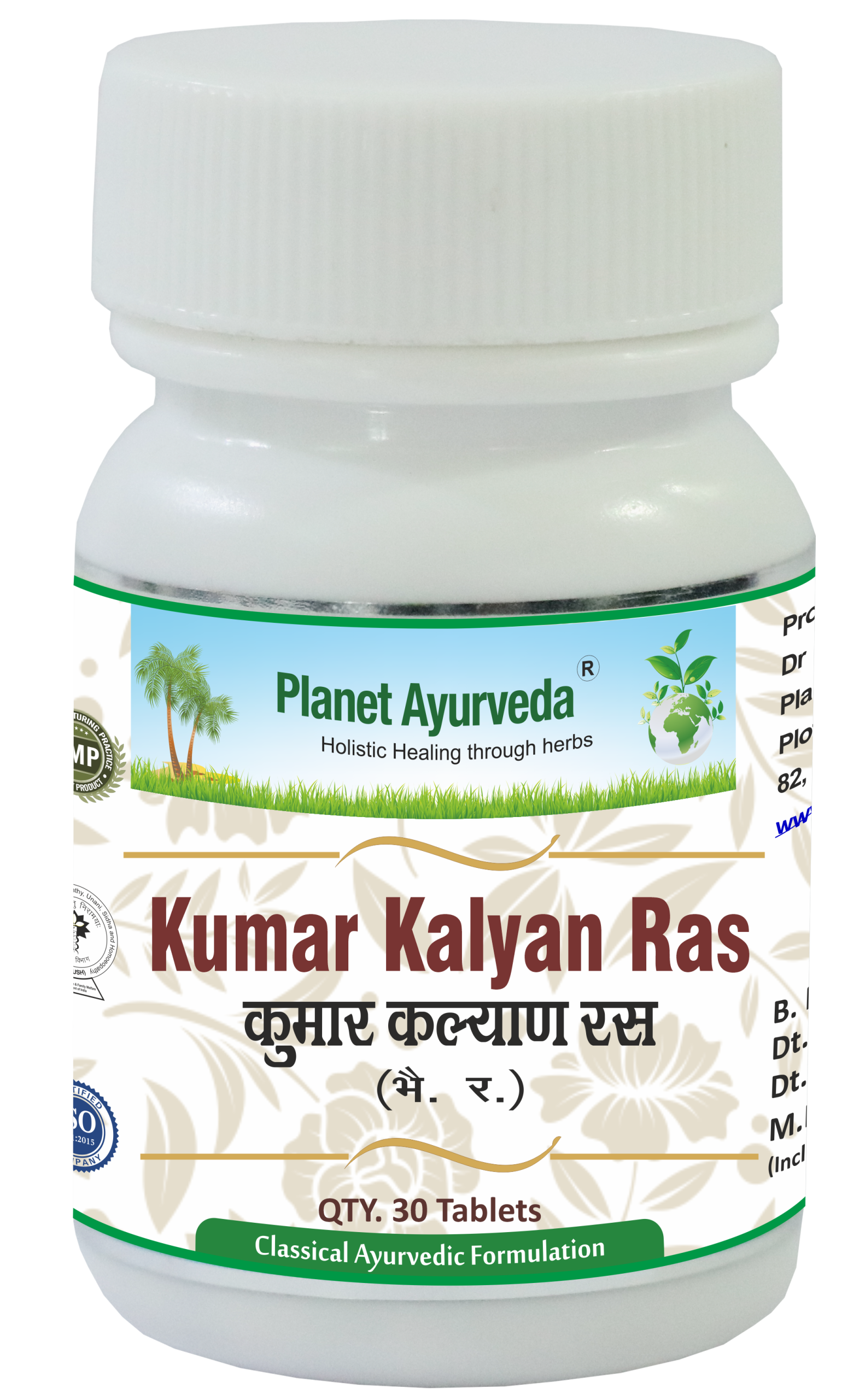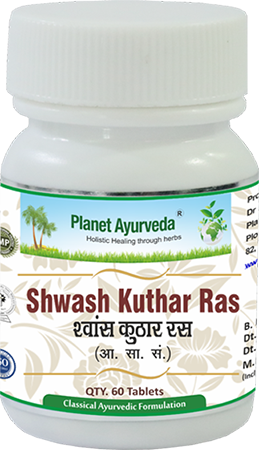Reference
Bhaishajya-Ratnavali Balrogadhikar Chapter 71 Verse-116-119
Abstract
Immunity plays a vital role in safeguarding children against infections, allergies, and chronic illnesses, especially in today’s fast-paced, pollution-prone environment. A strong immune system supports healthy growth, cognitive development, and resilience against modern health challenges. As antibiotic resistance and lifestyle-related illnesses become more common, people are increasingly turning to natural remedies for safer and lasting health solutions. Ayurveda, the ancient Indian system of medicine, offers holistic immunity-boosting remedies. Kumar Kalyan Ras, a revered Ayurvedic formulation, is known to enhance immunity, improve digestion, and strengthen overall vitality in children, offering a safe and time-tested alternative for long-term health and wellness. Let’s start discussing it in detail!!
Introduction
Kumar Kalyan Ras is a classical Ayurvedic herbo-mineral formulation specifically designed for pediatric care. The name breaks down as follows: "Kumar" means child, "Kalyan" signifies well-being or auspiciousness, and "Ras" refers to a mercurial or mineral-based preparation in Rasashastra. Thus, the name implies a remedy that promotes the overall health and prosperity of children. This formulation is known for its potent rejuvenating properties, it supports physical growth, mental development, and immunity. The formulation integrates precious bhasmas like Swarna (gold) and Mouktik (pearl), reflecting its holistic and nourishing approach to childhood wellness.
Classical Indication
Balrog (Pediatric care)
Ingredients
- Swarna Bhasma – Calx of Gold – 1 part
- Rajat Bhasma – Calx of Silver – 1 part
- Abhrak Bhasma (Shatputi) – Purified and incinerated mica – 1 part
- Loha Bhasma – Calx of Iron – 1 part
- Mouktik Bhasma – Calx of Pearl – 1 part
- Rasa Sindoor – A compound of purified mercury and sulphur – 1 part
- Grinding Medium (Bhavana Dravya) – Juice of Aloe vera (Kumari swarasa) (Quantity sufficient)
Kumar Kalyan Ras by Planet Ayurveda
Description of the Ingredients
1. Ras Sindoor (Red Sulphide of Mercury)
It has Rasayana (rejuvenative) and Yogavahi (catalytic) properties with Ushna Veerya (hot potency). It pacifies Vata and Kapha dosha and enhances immunity, digestion, and mental strength in children. It is especially useful in developmental delays and respiratory conditions.
2. Moti Bhasma (Pearl Calcium)
It possesses Madhura (sweet) and Shita Veerya (cold potency) and pacifies Pitta and Vata. This formulation is rich in natural calcium, supports bone formation, teething, and heart health in children. It also promotes calmness and improves sleep quality.
3. Swarn Bhasma (Calcined Gold)
It is Madhura-Tikta (sweet-bitter) in taste, with Sheeta Veerya (cool potency), and acts as a powerful Rasayana. It enhances Medha (intellect), Bala (strength), and Ojas (vitality). In children, it is used to promote brain development and enhance immunity.
4. Abhrak Bhasma (Purified Mica Ash)
Abhrak is Tridosha-hara (balances the three doshas), with Madhura-Tikta rasa (sweet-bitter taste) and Ushna Veerya (hot potency). It improves respiratory health, strength, and Agni (digestive fire). In pediatrics, it helps in chronic cough, poor digestion, and general developmental delays.
5. Loha Bhasma (Calcined Iron Ash)
It is Tikta-Kashaya (bitter-astringent) in taste and has Ushna Veerya (hot potency). It pacifies Kapha and Vata and acts as a potent hematinic. Useful in childhood anemia, it boosts blood formation, improves complexion, and strengthens overall health.
6. Vaikranta Bhasma (Tourmaline Ash)
It has Tikta-Kashaya rasa (bitter-astringent taste) and Ushna Veerya (hot potency). It balances Vata and Kapha doshas. In pediatric use, it supports respiratory strength, immunity, and energy, especially in chronic or recurrent illnesses.
7. Kumari Swaras (Aloe Vera Juice)
It possesses Tikta-Kashaya rasa (bitter-astringent taste) and Sheeta Veerya (cool potency), pacifying Pitta and Vata. In children, it aids digestion, acts as a mild laxative, improves liver function, and reduces inflammation in fevers and gastrointestinal issues.
Method Of Preparation
- Mix all the ingredients (equal quantities) in a clean Khalwa Yantra (mortar and pestle).
- Add Bhavana Dravya (Liquid for trituration) – Kumari Swarasa (Aloe vera juice) is used.
- Mix thoroughly with the juice and triturate the mixture for 3–6 hours continuously until a homogeneous semi-solid paste is formed.
- Roll the mass into small pills/vatis of approximately 62.5 mg – 125 mg (For pediatric use).
- Dry the tablets. Keep them in a cool, dry, shaded area.
- Avoid sun drying to preserve potency.
Medicinal Properties
- In jvara (fever), especially chronic or recurrent, with honey and tulsi swarasa.
- In kasa and shvasa (cough and breathing difficulties), with vasa swarasa or honey.
- In grahaṇi (IBS-like conditions and indigestion), with buttermilk or jeera water.
- In annaprashana vikara (feeding difficulties in infants), with ghrita or honey.
- In cases of unmada, delayed milestones, or poor cognitive development, with the use of Brahmi swarasa (juice of Bacopa monnieri).
- In krimi (intestinal worm infestation), with vidanga churna powder of Embelia ribes and honey.
- In daurbalya (general weakness or convalescence), with milk and cow’s ghee.
- In failure to thrive or malnutrition, with ashwagandha churna (powder of Withania somnifera) and milk.
- In rickets and bone developmental disorders, with guduchi (Tinospora cordifolia) and Arjuna kwatha (decoction of Terminalia arjuna).
Impact on Dosha
Tridosha-shamaka (reduces the aggravated three doshas), with a special focus on pacifying Kapha and Vata.
Indications
- Breathing difficulty / Childhood asthma (Shvasa)
- Diarrhea (Atisara)
- Digestive disorders, malabsorption (Grahani)
- Intestinal worm infestation (Krimi)
- General weakness or debility (Daurbalya)
- Anorexia or loss of appetite (Aruchi)
- Loss of strength and vitality (Balābhramsha)
- Mental disturbances or behavioral disorders (Unmada)
- Poor mental development (Mano-mandya)
- Weak digestive fire (Mandagni)
- Rickets-like symptoms in children (Phakka Roga)
- Tissue depletion disorders (Dhatu-ksaya Janya Vikara)
Dosage
Pediatric Dose :62.5 mg – 125 mg, once or twice daily
Adjust dose based on age, strength, and severity.
Contraindications
Not noticed. But consult an Ayurvedic Physician before use for dosage.
Why Choose Planet Ayurveda's Kumarkalyan Ras
- This is prepared under expert Ayurvedic physicians following classical ancient formulations.
- The product is made with pure, high-quality ingredients, ensuring safety for long-term use.
- It supports a healthy immune system.
- 100% natural product. Pure Vegetarian Formula
- Free from chemicals, preservatives, starch, additives, colors, yeast, binders, fillers, etc.
Conclusion
Kumar Kalyan Ras is a potent rejuvenator medicine known for its three dosha balancing action, with a special focus on pacifying Kapha and Vata. It targets vital tissues like lymphatic fluids, digestive enzymes, blood tissues, bone marrow, and the body’s immunity, and acts primarily on the gastrointestinal system. The properties of this Rasayana (rejuvenating medicine) nourish all seven dhatus (body tissues), purify the blood, and strengthen immunity. Its efficacy in managing digestive disorders, weakness, and developmental delays makes it beneficial across all pediatric stages, truly justifying its name as a "Kalyankar" (benefactor) formulation for children.








